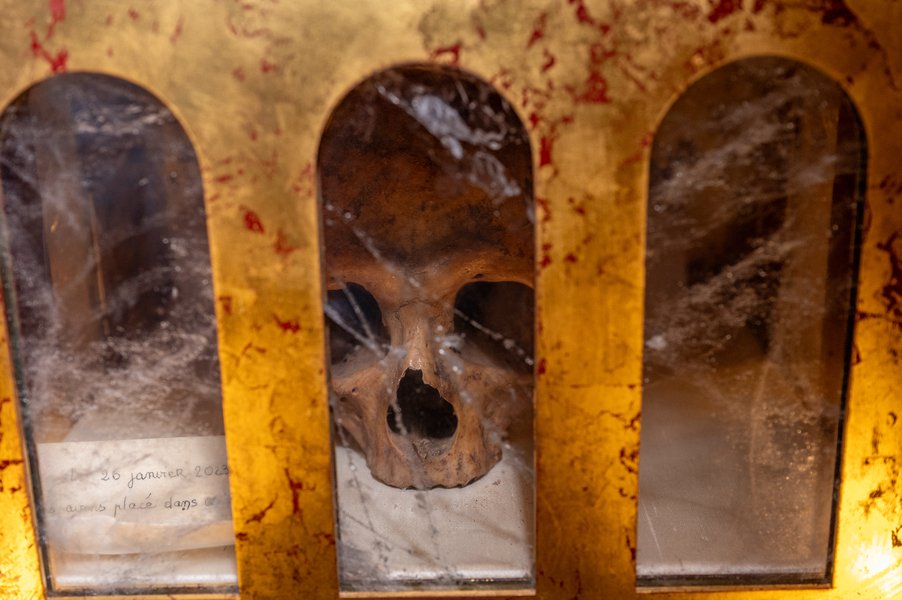
BALTIMORE (OSV News) — Kneeling before a glass-clad box holding what many believe to be the skull of St. Thomas Aquinas, Michele Hafenmair touched her rosary and other sacramentals to the relic of the 13th-century Italian philosopher and theologian.
Then, after snapping a few photos, the parishioner of Our Lady of Grace in Parkton, Maryland, quietly pressed her own head against the reliquary bearing the cranium that once held the mind of one of the greatest thinkers in the history of the Catholic Church.
She asked the Dominican saint to pray to bring back some members of her family more fully into the life of the church.
“I prayed that he (would) intercede for them and bring them back to the sacraments,” said Hafenmair, who arrived at Ss. Philip and James in Baltimore around 2:30 p.m. on December 18 and meditated in the presence of the major relic for more than 90 minutes. “Saints are powerful intercessors for us and St. Thomas Aquinas is near and dear to my heart.”
Hafenmair was one of more than 1,500 people who visited Ss. Philip and James on December 17-18 to pray and venerate the relic of St. Thomas Aquinas. The Dominican-led parish was the final stop of a tour sponsored by the Dominican Province of St. Joseph that included visits to 11 sites in seven states and the District of Columbia.
Last year marked the 700th anniversary of St. Thomas Aquinas’ canonization. This year is the 750th anniversary of his death and next year will be the 800th anniversary of the birth of a man who wrote highly influential theological texts, including his masterpiece, “Summa Theologiae.”
Dominican Father Michael Weibley, pastor of Ss. Philip and James, noted that the skull was entrusted to the Dominicans of southern France about 100 years after St. Thomas Aquinas’ death. It is housed at a Dominican church in Toulouse, France.
Back in 1274, St. Thomas Aquinas was sent on a mission by Pope Gregory X to serve at the Second Council of Lyon in France. During his journey there along the Appian Way, Father Weibley said, St. Thomas struck his head on a tree branch while riding a donkey.
“We think he probably had a brain aneurysm and he ended up passing away in the Cistercian abbey in Fossanova,” Father Weibley told the Catholic Review, Baltimore’s archdiocesan news outlet.
Because St. Thomas Aquinas was such a holy man, the Cistercians kept his body with them — causing a major dispute with the Dominicans, the pastor noted. After many decades, the pope asked the Cistercians to return most of the relics, which is how the skull came into the possession of the French Dominicans.
That history helps in knowing that the skull venerated at Ss. Philip and James is the actual one of the saint, Father Weibley said. There is another skull that some claim to be that of St. Thomas Aquinas that is held in Piverno, Italy. The Catholic Church allows veneration of both until DNA testing can be completed.
“Several miracles have been attributed to this relic,” said Father Weibley, sitting near the skull on December 18 prior to opening Ss. Philip and James church for veneration of the object. “That shows the kind of authenticity — that the Lord is working through that. And so for those who have faith, it’s a beautiful thing.”
Venerating relics is closely connected to belief in the reality of the Incarnation, Father Weibley said.
“He imbued our bodies with the divine presence in such a way that he gave it this great and noble dignity,” Father Weibley said, noting that Catholics believe in the resurrection of the dead at the end of the world. “This skull will be reunited one day with the soul of St. Thomas, which is now sitting in the glory of heaven, seeing God face-to-face in the beatific vision.”
More than 600 people attended a December 18 evening Mass at Ss. Philip and James in the presence of the relic. They included people of all ages and many young families. During the liturgy, the congregation chanted Latin eucharistic hymns originally composed by St. Thomas Aquinas. At the end of Mass, white-robed Dominicans held the skull aloft on a wooden bier hoisted onto their shoulders. Onlookers bowed their heads or crossed themselves as the relic passed by in a solemn procession.
Eric and Esther Lee, who attend Mass at St. Pius X Chapel in Upper Marlboro, brought their seven children, ranging in age from six months to 16, to venerate the relic before a Eucharistic holy hour on December 18 at Ss. Philip and James.
“It’s so precious to have this opportunity,” said Esther Lee, noting that she and her husband are converts to the Catholic faith from Protestantism. They homeschool their children.
“When I was venerating the relic,” Ester Lee added, “I was thinking about St. Thomas Aquinas’ impact on Western civilization.”
Eian Lee, 11, said it was amazing to gaze upon the skull that “held” the prayers of St. Thomas Aquinas.
In his homily at the December 18 evening Mass, Dominican Father Patrick Briscoe, editor of Our Sunday Visitor, said St. Thomas Aquinas wasn’t some academic isolated in an ivory tower. The saint understood the nitty-gritty realities of everyday life, he said.
“We see in the skull of St. Thomas Aquinas the residue of that mind which formulated countless prayers, which recalled countless intentions, which turned over every word of Sacred Scripture — a mind which suffered fatigue and frustration,” Father Briscoe said.
Father Weibley prays that the visit of the relic to Baltimore will be a blessing to his parish, the Archdiocese of Baltimore, and the greater Baltimore community.
“Not only was St. Thomas Aquinas a great theologian and philosopher, but he was a great poet and wrote beautiful poetry about the Eucharist,” Father Weibley said. “He was the instigator of the feast of Corpus Christi that we have today … and he wrote some of the beautiful texts about the Eucharist. So his legacy is vast.”
– – –
George P. Matysek Jr. is managing editor of the Catholic Review, news outlet of the Archdiocese of Baltimore.


